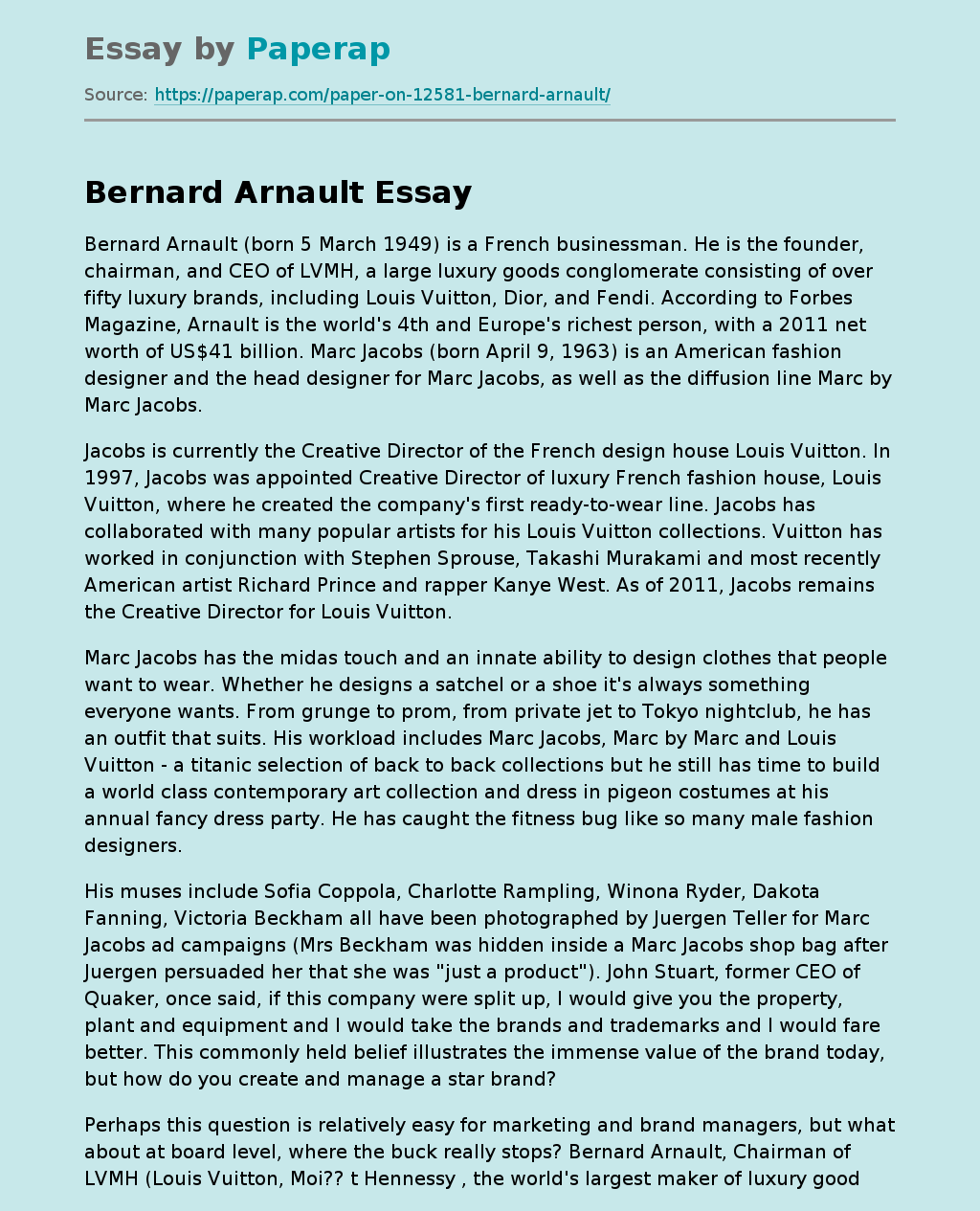Bernard Arnault
Bernard Arnault (born 5 March 1949) is a French businessman. He is the founder, chairman, and CEO of LVMH, a large luxury goods conglomerate consisting of over fifty luxury brands, including Louis Vuitton, Dior, and Fendi. According to Forbes Magazine, Arnault is the world’s 4th and Europe’s richest person, with a 2011 net worth of US$41 billion. Marc Jacobs (born April 9, 1963) is an American fashion designer and the head designer for Marc Jacobs, as well as the diffusion line Marc by Marc Jacobs.
Jacobs is currently the Creative Director of the French design house Louis Vuitton. In 1997, Jacobs was appointed Creative Director of luxury French fashion house, Louis Vuitton, where he created the company’s first ready-to-wear line. Jacobs has collaborated with many popular artists for his Louis Vuitton collections. Vuitton has worked in conjunction with Stephen Sprouse, Takashi Murakami and most recently American artist Richard Prince and rapper Kanye West. As of 2011, Jacobs remains the Creative Director for Louis Vuitton.
Marc Jacobs has the midas touch and an innate ability to design clothes that people want to wear.
Whether he designs a satchel or a shoe it’s always something everyone wants. From grunge to prom, from private jet to Tokyo nightclub, he has an outfit that suits. His workload includes Marc Jacobs, Marc by Marc and Louis Vuitton – a titanic selection of back to back collections but he still has time to build a world class contemporary art collection and dress in pigeon costumes at his annual fancy dress party.
He has caught the fitness bug like so many male fashion designers.
His muses include Sofia Coppola, Charlotte Rampling, Winona Ryder, Dakota Fanning, Victoria Beckham all have been photographed by Juergen Teller for Marc Jacobs ad campaigns (Mrs Beckham was hidden inside a Marc Jacobs shop bag after Juergen persuaded her that she was “just a product”). John Stuart, former CEO of Quaker, once said, if this company were split up, I would give you the property, plant and equipment and I would take the brands and trademarks and I would fare better. This commonly held belief illustrates the immense value of the brand today, but how do you create and manage a star brand?
Perhaps this question is relatively easy for marketing and brand managers, but what about at board level, where the buck really stops? Bernard Arnault, Chairman of LVMH (Louis Vuitton, Moi?? t Hennessy , the world’s largest maker of luxury goods), appears to have some of the answers. LVMH is a paradox in itself. A company that makes and sells products that nobody actually needs. A recipe for disaster? A manager’s nightmare? Far from it – LVMH’s combined revenue was estimated at $11 billion in 2001, with a market capitalization of $27 billion.
With Arnault at the helm, this organization has gone from a small clothing manufacturer on the verge of ruin to a conglomerate of nearly 50 star brands including Dom Perignon, TAG Heuer and Christian Dior. According to Arnault, one key to success is his management technique. The process of creating a star brand begins with radical innovation and, for that, artists must be totally free from financial or marketing concerns. He firmly believes that “If you think and act like a typical manager around creative people – with rules, policies, data on customer preferences, and so forth – you will quickly kill their talent.
” It is only later, when the product is being manufactured, that he introduces the strict, almost militant processes that ensure profitability. Take, for example, John Galliano and his dresses made out of newspaper surely the most impractical product imaginable. But when they were sent down the cat-walk, Arnault did not bat an eyelid. Consequently, when Dior sold dresses in newspaper-printed fabric for a considerable profit, Arnault was proved right. Star brands, in his opinion, are in themselves a paradox. They must simultaneously be timeless, modern, fast-growing and highly profitable.
Arnault is keenly aware of the crucial role he plays in creating such an entity. He observes how “many brands have the potential to be stars but they are poorly managed”, and by this we are not talking of the marketing manager alone – the problem often runs through the heart of most major organizations. If you continually pose these questions to consumers and analyze the findings, it becomes increasingly simple to pick up on small irritations or concerns that, in the future, could present massive problems for your brand.
(2) See the brand as both an object and a person. Viewing the brand as an object increases the value of analysis and plays a fundamental and consistent role – you are selling something to people. On the other hand, the brand as a person enables you to understand the delivery of this role and how well it fits into your corporate culture. This way you can become involved with the projection and promotion of the brand without ever losing sight of the bigger picture. (3) Look at “brand promise” to enable successful advertising.
Bernard Arnault. (2018, Jan 14). Retrieved from https://paperap.com/paper-on-12581-bernard-arnault/

